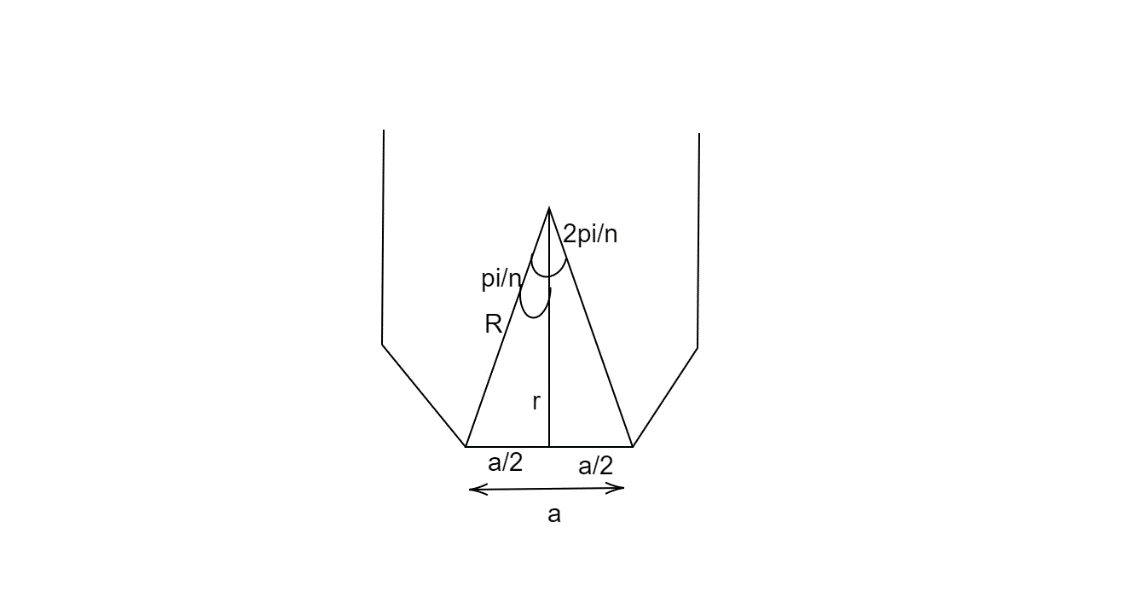
If R and r are the radii of the circumcircle and incircle of a regular polygon of n sides, each side being of length a. Then find the value of a.
A. $2(R + r)\sin \left( {\dfrac{\pi }{{2n}}} \right)$
B. $2(R + r)\tan \left( {\dfrac{\pi }{{2n}}} \right)$
C. $2(R + r)$
D. None of these
Answer
216.3k+ views
Hint: In order to solve the question, first find the required angle. Then using the figure write the values of R and r. Finally, find the sum of the radii of the circumcircle and incircle to find the value of a.
Formula Used:
$\tan \theta = \dfrac{{\cos \theta }}{{\sin \theta }}$
$\sin 2\theta = 2\sin \theta \cos \theta $
$\cos 2\theta = 2{\cos ^2}\theta - 1$
Complete step by step solution:
Given that
The radii of the circumcircle are R.
The radii of the incircle are r.
Consider the figure given below.

Image: Regular polygon
Here the total angle is $\dfrac{{2\pi }}{n}$.
Then the half-angle will be
$\dfrac{{2\pi }}{{2n}} = \dfrac{\pi }{n}$
From the figure, we can write that
$\dfrac{{\dfrac{a}{2}}}{R} = \sin \dfrac{\pi }{n}$
$a = 2R\sin \dfrac{\pi }{n}$. . . . . . (1)
Also, we can write that
$\dfrac{{\dfrac{a}{2}}}{r} = \tan \dfrac{\pi }{n}$
$a = 2r\tan \dfrac{\pi }{n}$. . . . . . (2)
From equation (1), we can find that
$R = \dfrac{a}{{2\sin \dfrac{\pi }{n}}}$
And from equation (2), we can write that
$r = \dfrac{a}{{2\tan \dfrac{\pi }{n}}}$
$r = \dfrac{{a\cos \dfrac{\pi }{n}}}{{2\sin \dfrac{\pi }{n}}}$ ( since $\tan \theta = \dfrac{{\cos \theta }}{{\sin \theta }}$)
Next, we will find the sum $R + r$, that is
$R + r = \dfrac{a}{{2\sin \dfrac{\pi }{n}}} + \dfrac{{a\cos \dfrac{\pi }{n}}}{{2\sin \dfrac{\pi }{n}}}$
$R + r = \dfrac{a}{{2\sin \dfrac{\pi }{n}}}\left( {1 + \cos \dfrac{\pi }{n}} \right)$
$a = 2\left( {R + r} \right)\left( {\dfrac{{\sin \dfrac{\pi }{n}}}{{1 + \cos \dfrac{\pi }{n}}}} \right)$
$a = 2\left( {R + r} \right)\left( {\dfrac{{2\sin \dfrac{\pi }{{2n}} \times \cos \dfrac{\pi }{{2n}}}}{{1 + 2{{\cos }^2}\dfrac{\pi }{{2n}} - 1}}} \right)$. . . . . . (Since $\sin 2\theta = 2\sin \theta \cos \theta $ and $\cos 2\theta = 2{\cos ^2}\theta - 1$)
$a = 2\left( {R + r} \right)\left( {\dfrac{{\sin \dfrac{\pi }{{2n}}}}{{\cos \dfrac{\pi }{{2n}}}}} \right)$
$a = 2\left( {R + r} \right)\tan \dfrac{\pi }{{2n}}$
Option ‘B’ is correct
Note: Students can get confused while taking the angle. Always start solving by drawing a rough figure using the given information. Care should be taken while applying trigonometric identities.
Formula Used:
$\tan \theta = \dfrac{{\cos \theta }}{{\sin \theta }}$
$\sin 2\theta = 2\sin \theta \cos \theta $
$\cos 2\theta = 2{\cos ^2}\theta - 1$
Complete step by step solution:
Given that
The radii of the circumcircle are R.
The radii of the incircle are r.
Consider the figure given below.

Image: Regular polygon
Here the total angle is $\dfrac{{2\pi }}{n}$.
Then the half-angle will be
$\dfrac{{2\pi }}{{2n}} = \dfrac{\pi }{n}$
From the figure, we can write that
$\dfrac{{\dfrac{a}{2}}}{R} = \sin \dfrac{\pi }{n}$
$a = 2R\sin \dfrac{\pi }{n}$. . . . . . (1)
Also, we can write that
$\dfrac{{\dfrac{a}{2}}}{r} = \tan \dfrac{\pi }{n}$
$a = 2r\tan \dfrac{\pi }{n}$. . . . . . (2)
From equation (1), we can find that
$R = \dfrac{a}{{2\sin \dfrac{\pi }{n}}}$
And from equation (2), we can write that
$r = \dfrac{a}{{2\tan \dfrac{\pi }{n}}}$
$r = \dfrac{{a\cos \dfrac{\pi }{n}}}{{2\sin \dfrac{\pi }{n}}}$ ( since $\tan \theta = \dfrac{{\cos \theta }}{{\sin \theta }}$)
Next, we will find the sum $R + r$, that is
$R + r = \dfrac{a}{{2\sin \dfrac{\pi }{n}}} + \dfrac{{a\cos \dfrac{\pi }{n}}}{{2\sin \dfrac{\pi }{n}}}$
$R + r = \dfrac{a}{{2\sin \dfrac{\pi }{n}}}\left( {1 + \cos \dfrac{\pi }{n}} \right)$
$a = 2\left( {R + r} \right)\left( {\dfrac{{\sin \dfrac{\pi }{n}}}{{1 + \cos \dfrac{\pi }{n}}}} \right)$
$a = 2\left( {R + r} \right)\left( {\dfrac{{2\sin \dfrac{\pi }{{2n}} \times \cos \dfrac{\pi }{{2n}}}}{{1 + 2{{\cos }^2}\dfrac{\pi }{{2n}} - 1}}} \right)$. . . . . . (Since $\sin 2\theta = 2\sin \theta \cos \theta $ and $\cos 2\theta = 2{\cos ^2}\theta - 1$)
$a = 2\left( {R + r} \right)\left( {\dfrac{{\sin \dfrac{\pi }{{2n}}}}{{\cos \dfrac{\pi }{{2n}}}}} \right)$
$a = 2\left( {R + r} \right)\tan \dfrac{\pi }{{2n}}$
Option ‘B’ is correct
Note: Students can get confused while taking the angle. Always start solving by drawing a rough figure using the given information. Care should be taken while applying trigonometric identities.
Recently Updated Pages
JEE Atomic Structure and Chemical Bonding important Concepts and Tips

JEE Amino Acids and Peptides Important Concepts and Tips for Exam Preparation

Electricity and Magnetism Explained: Key Concepts & Applications

Chemical Properties of Hydrogen - Important Concepts for JEE Exam Preparation

JEE Energetics Important Concepts and Tips for Exam Preparation

JEE Isolation, Preparation and Properties of Non-metals Important Concepts and Tips for Exam Preparation

Trending doubts
JEE Main 2026: Application Form Open, Exam Dates, Syllabus, Eligibility & Question Papers

Derivation of Equation of Trajectory Explained for Students

Hybridisation in Chemistry – Concept, Types & Applications

Understanding the Angle of Deviation in a Prism

Understanding Collisions: Types and Examples for Students

How to Convert a Galvanometer into an Ammeter or Voltmeter

Other Pages
JEE Advanced Marks vs Ranks 2025: Understanding Category-wise Qualifying Marks and Previous Year Cut-offs

NCERT Solutions for Class 11 Maths Chapter 10 Conic Sections

NCERT Solutions for Class 11 Maths Chapter 9 Straight Lines

NCERT Solutions For Class 11 Maths Chapter 8 Sequences And Series

Understanding Atomic Structure for Beginners

NCERT Solutions For Class 11 Maths Chapter 12 Limits And Derivatives




